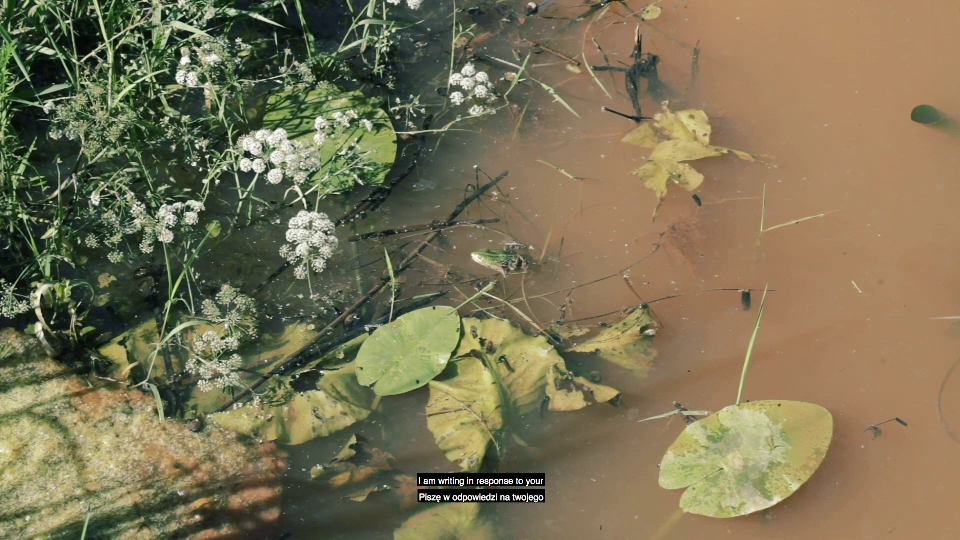Diana Lelonek
Forms of Survival
Diana LelonekForms of Survival, 2020HD video, 8 min, texts, photos, field recordings, ed. 1/3editing: Diana Lelonek, voice-over: Sandra Babij, studio recordings and sound mastering: Marcin Partyka
Collection II of the Arsenal Gallery in Białystok. Work purchased by the Arsenal Gallery in 2021

Diana Lelonek’s Forms of Survival are a vision of the world (including the world of art) after a catastrophe. The narrative revolves around several short e-mail messages. They were inspired by authentic correspondence concerning the cancellation, postponement or transfer of planned exhibitions to the web, received by Lelonek from curators and gallery directors after the outbreak of the Sars-Cov-2 pandemic. The coronavirus outbreak froze the work of artists and art institutions, the production and distribution of artworks, for months. Lelonek’s work is one of many possible scenarios for the future of galleries, museums and artists in the face of the problems affecting contemporary societies: the climate crisis or the economic and political collapse.
In the film, Lelonek’s correspondents report on how they are coping with the new reality, as funding for cultural institutions has been withdrawn due to the crisis and some of those institutions were closed down. They accept with humility and understanding the fact that, in the face of drought and as part of humanitarian aid, museums and galleries have to fulfil more important functions. Exhibition halls are being turned into greenhouses or housing for disaster victims. Vegetables and fruit are grown in the areas around the buildings, beehives are set up on the roofs. Buildings are being gradually taken over by nature: moss is growing in the halls, trees are breaking through roofs, animals are finding shelter indoors. Their former workers restore rivers to their natural courses and eliminate drainage ditches. Others, in order to survive, go into hibernation and seek new forms of symbiosis with nature: they watch birds, grow vegetables, collect rhizomes and tubers; some live underground and their bodies “fuse with the roots and join the mycelium”. Paradoxically, however, they see this slowdown as a liberation. Now they are “living for real”: without the stress, without the efforts to obtain grants and the struggle with budgetary shortages. In Forms of Survival, criticism of the state’s cultural policy and the underfunding of cultural institutions is palpable. “We live very modestly, we’re good at it”, we hear.
Coming from off-screen is a female voice imitating voiceovers familiar from nature films, accompanied by utopian shots of nature. Human beings are invisible, there are no traces of their intervention. However, the idyllic, peacefully changing landscapes are permeated by anxiety. The sounds of nature do not bring solace. The post-disaster world is far from ideal.
Forms of Survival are linked with a rendered photograph The Exodus of People from the Gallery. Its title and representational layer refer to Zbigniew Libera’s dystopian photographic panorama The Exodus of People from the Cities (2010). The post-apocalyptic vision of a world without art is an image of civilisation being slowly annexed by nature. The scene was set in the littered courtyard of the Arsenal Gallery in Białystok, and its employees posed for the photograph. The building is in ruins, with boarded-up windows and plaster falling off the walls. Tree branches stick out of holes in the roof, its tiles are overgrown with grass. Dirty, shabbily clad people are removing derelict equipment from the interior. In Lelonek’s work, the difficult financial situation and uncertain future of the cultural institution is turned into a metaphor in a vision of the Arsenal Gallery’s death throes. In addition to the issue of the current crises, another theme can be cautiously proposed as present in The Exodus of People from the Gallery: the dispute over the relationship between nature and culture/art, which has been going on for centuries at, among others, the level of art theory. Lelonek’s work is a contemporary voice in these discussions, relating not so much to issues of aesthetics and the nature of imagery as to the social conditions of art production.
Izabela Kopania
translated from Polish by Klaudyna Michałowicz

PLAN YOUR VISIT
Opening times:
Thuesday – Sunday
10:00-18:00
Last admission
to exhibition is at:
17.30